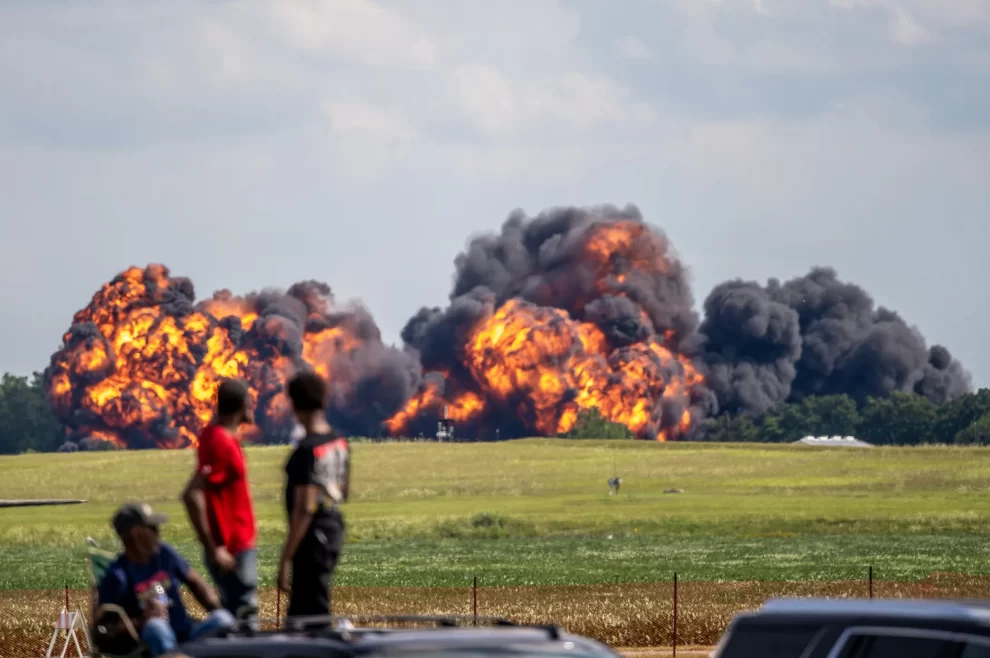The pilot of the Russian-made fighter jet that crashed earlier this month during the Thunder Over Michigan air show in Belleville was trying to land the plane while the backseater acknowledged to investigators he likely pulled the ejection handles for both of them, a preliminary investigation found.
The report suggested that moments before the jet hit the ground during the Yankee Air Museum’s annual event, the pilot and backseater — who were racing against the clock in a plummeting plane — had different views about what to do.
But once they did eject, blasting out of the aircraft and parachuting back to earth, the jet’s fate was sealed.
The recent report by the National Transportation Safety Board offered more insight into what happened during the Aug. 13 crash, but didn’t determine why the MiG-23 lost power before crashing. Nor did it conclude whether the pilot could have safely landed the plane or whether the backseater saved their lives.

The crash is significant because while the report said there were only minor injuries to those aboard the plane and no injuries on the ground, the jet missed hitting an apartment complex. The incident also has spurred some to question whether the potential for air show mishaps is worth the risks.
“Video evidence indicated that the airplane was in a left bank when the ejection seats fired,” the report said, adding “the airplane continued in the left bank and descended into the ground” about a mile away from the airport, leaving a 600-foot-long “wreckage path.”
Findings about the crash’s cause are likely to be a part of the final report, which could take months.
Air shows thrills, dangers
Air shows, which are held all over the world, dazzle spectators, who are amazed by gravity-defying feats, precision flying and what pilots can do in the air. The MiG’s flight was the second to last performance of the two-day annual show, which was in its 25th year.
But air shows also have had fatalities.
Just weeks before the Michigan crash, four people, including the daughter of a two-time Super Bowl winner, died in two separate incidents at the annual Experimental Aircraft Association AirVenture in Oshkosh, Wisconsin, which, according to news accounts, had drawn hundreds of thousands of people.
And last November, two World War II-era military aircraft collided in midair, killing all six aboard both planes at the Wings Over Dallas air show at Dallas Executive Airport in Texas. Fortunately, organizers said, there were no spectator injuries from the crash.
In metro Detroit, when the plane did go down, it was in front of thousands of spectators, including kids.

Moreover, officials noted that had the 1981 former military aircraft come down any closer to the Waverly on the Lake apartments, it is possible many could have been killed.
“It is fortunate no one on the ground was injured,” John Brannen, who is overseeing the investigation, said earlier this month at the crash site. “In this case, we have a fairly large airplane and the fact that both pilots survived and there were no ground injuries is a very good outcome.”
Up against time, altitude
The MiG pilot, Dan Filer, of Texas, told investigators that the flight left Willow Run Airport’s runway near Ypsilanti and made a low-level pass, according to the safety board’s report. Filer started banking when he noticed that the engine afterburner failed to ignite and that their airspeed had slowed.
Filer, who also is the aircraft’s owner, is an experienced pilot. A retired Navy aviator who flew jets off aircraft carriers and became a commercial pilot, he has been portrayed in news reports as a real-life Pete Mitchell, the character played by Tom Cruise in the “Top Gun” movies.

When the jet’s afterburner failed, he tried to increase lift by bringing the MiG’s swing wings forward and troubleshoot the problem, the report said. But the rear seat observer, who has not been named, told him that they needed to eject.
Filer was still trying to resolve the problem and maneuver the airplane toward a runway, but his ejection seat fired and he was launched out of the aircraft, the report said. If either person pulls the handle, he told investigators, both seats eject.
The rear seat observer said the aircraft made a pass along the runway and the plan was to go to the left for another pass followed by a landing, but the engine was not accelerating and he and the pilot “had a brief discussion and began to climb up and gain altitude.”
Then, he said, they decided “they had some type of engine problem and needed to get back on the ground.”
The rear seat observer added, the report said, they determined they did not have sufficient altitude to land, were pressed for time and “needed to get out” of the aircraft. When asked whether he had pulled the ejection seat handles, he replied he “could not specifically remember, but thinks that he would have.”
Source : Detroi Free Press






























